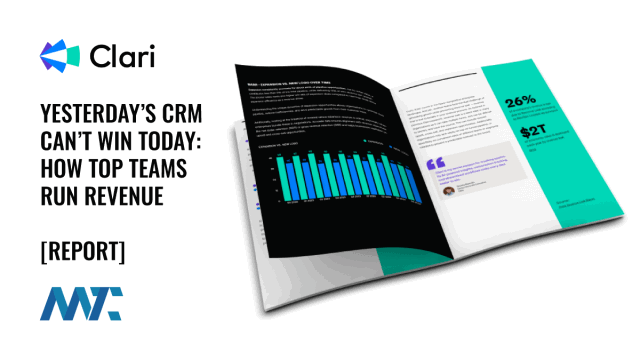The average company is hemorrhaging over $2 trillion annually due to revenue leak.
The enterprise pipeline is leaking opportunities at every stage. This is primarily due to missed forecasts, poor handoffs, and stalled deals — and it’s happening in plain sight.
This isn’t a people problem. It’s a system failure driven by outdated CRMs and siloed processes. Marketing, sales, and customer success teams were built to guide the customer journey. However, they’re disconnected in most organizations, each focused on narrow KPIs rather than the full revenue lifecycle. This fragmented execution creates gaps across pipeline coverage, upsell opportunities, and deal progression – ultimately leading to missed forecasts and blindsided leadership.
As inflation, shifting buyer priorities, and longer sales cycles add pressure, the need for predictable, efficient growth is a top priority. The State of Enterprise Revenue 2025 uncovered that top-performing companies are not waiting to fix revenue leaks. They are moving beyond CRM guesswork and rebuilding their revenue systems now, adopting AI-powered execution and revenue orchestration to close deals 20% faster.
Why Legacy CRM Tools Fail
Ninety-Eight percent of companies don’t consistently track why deals are lost.
Traditional CRMs are falling short, and the impact is staggering. That’s because most CRMs aren’t built to capture structured loss reasons, leaving teams with fragmented, ad-hoc data that provides minimal insight or value.
Without clear visibility into why opportunities slip away, companies struggle to recover lost revenue or avoid making the same mistakes.
At their core, traditional CRMs were designed to document the past, not drive the future. They’re static, siloed, and slow, built for recordkeeping rather than real-time execution. In today’s fast-paced, competitive environment, that leaves businesses blind to risk, misaligned across teams, and increasingly vulnerable to revenue leak.
Revenue Orchestration — Moving Beyond CRM Guesswork
Revenue Orchestration, on the other hand, is built to shape the future. The process unifies forecasting, deal execution, and pipeline management in real time across marketing, sales, finance, and customer success. It replaces manual guesswork with coordinated, data-driven execution.
AI plays a central role in this transformation. Winning teams use AI to prioritize deals, predict buyer intent, surface objections and risks early, and automate workflows. By analyzing structured revenue data across the funnel, AI helps uncover inefficiencies and drive more informed, confident decisions.
AI helps marketing and sales teams operate as a single system of action, optimizing every lost opportunity. Here’s how it works:
AI connects the dots—identifying patterns, enabling precision outreach, and preventing revenue leak before it happens.
Sales captures structured insights on lost deals automatically, without slowing down rep productivity.
Marketing accesses these insights instantly, optimizing targeting, messaging, and buyer engagement strategies.
Revenue teams close the loop faster, recovering missed opportunities, improving pipeline quality, and boosting forecast accuracy.
Marketing & Sales Synergy: A Key Revenue Growth Driver
Today’s best revenue teams operate as a unified system. Every handoff is seamless, every customer interaction is purposeful, and real-time data drives every decision.
Yet for many organizations, the traditional silos between sales and marketing still slow progress and leave revenue on the table. Both functions are tasked with driving growth, but they often approach it from different angles. In fact,
54% of revenue teams still lack functional handoffs between marketing and sales.
Without shared visibility and alignment, pipeline slips through the cracks. By bringing clarity, speed, and predictability to deal execution, AI empowers marketing and sales to move in lockstep. No more finger-pointing. No more “messy middle” between lead generation and closed-won deals. Instead, AI creates a common operating rhythm based on shared context and real-time insights.
AI, Alignment, and the New Blueprint for Predictable Revenue Growth
Revenue leaders now face a defining choice: will your team be part of the top 2% driving predictable growth, or part of the 98% struggling to keep up? AI-powered Revenue Orchestration is fundamentally rewriting the playbook for revenue execution. Sales and marketing teams are now data-driven strategists using AI to anticipate customer needs and deliver personalized solutions.
However, realizing AI’s full potential requires more than new technology. Marketing and sales must operate in lockstep, using AI-driven insights to analyze buyer behavior, optimize engagement strategies, and create revenue orchestration models that eliminate leaks.
The future of revenue execution is here. It runs on AI, automation, and alignment. Companies that hesitate will be left behind in a landscape that rewards clarity, precision, and unified execution. Those that invest in orchestrated, real-time revenue systems will drive faster, more predictable, and scalable growth.
Download The State of Enterprise Revenue 2025
©2025 DK New Media, LLC, All rights reserved | Disclosure
Originally Published on Martech Zone: Yesterday’s CRM Can’t Win Today: How Top Teams Run Revenue

